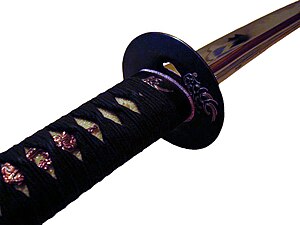Battōjutsu
(Redirected from Battodo)
 | |
| Focus | Weaponry |
|---|---|
| Hardness | Non-competitive |
| Country of origin | |
| Creator | - |
| Parenthood | Kenjutsu (Sword craft) To-ho (Sword method) |
| Olympic sport | No |
Battōjutsu (抜刀術, battō-jutsu) ("the craft of drawing out the sword") is an old term for iaijutsu (居合術). Battōjutsu is often used interchangeably with the terms iaijutsu and battō (抜刀).[1]
Generally, battōjutsu is practiced as a part of a classical ryū and is closely integrated with the tradition of kenjutsu. It is practised with a live blade (katana), often simply as solo kata.[1] The training is for combative effectiveness,[2] through factors such as distancing, timing and targeting. As such, battōjutsu is not intended for sport-like or "spiritual" purposes as are modern budō like iaido and kendo.[3]
List of schools
This section needs additional citations for verification. (September 2021) |
Old school:
- Shinmei Muso Ryu Battōjutsu (神明夢想流 抜刀術), founded by Hayashizaki Jinsuke (Minamoto no) Shigenobu(林崎甚助(源)重信) (c. 1542–1621)
- Sekiguchi Ryu Battōjutsu (or Iai) (関口流抜刀術), founded by Sekiguchi Ujinari (関口氏業) (1636–1716)
Modern schools developed after the beginning of the Meiji era:
- Toyama-ryū (戸山流), founded in 1925 at Japanese Army Toyama Academy (陸軍戸山学校). This system of swordsmanship was developed for the military by a committee of prominent martial artists. First, Lieutenant Colonel Morinaga Kiyoshi (森永清 中佐) selected 5 kata produced by Nakayama Hakudō (中山博道) arranged tachi-iai. Toyama-ryu was not taught generally but was reserved for officers, as they still carried swords. In 1940, Mochida Seiji (持田盛二) and Saimura Goro (斎村吾郎) added and revised the kata. In November of that year, an official manual on Toyama-ryu was distributed widely within the Japanese Army. In 1942, a running slash-type kata geared toward cavalry charges was added.
- Nakamura-ryū (中村流), founded in the mid-20th century by Nakamura Taizaburō (中村泰三郎), who had previously taught Toyama-ryū.[4]
- Zen Nihon Batto Do Renmei (全日本抜刀道連盟) or ZNBDR was created in 1977 under Nakamura Taizaburo which practice 5 Shoden Seitei and 8 Chuden Seitei Kata.
References
- ^ a b Armstrong, Hunter B. (1995) "The Koryu Bujutsu Experience" in Koryu Bujutsu: Classical Warrior Traditions of Japan (ed. Diane Skoss). Koryu Books. Page 32. ISBN 1-890536-04-0
- ^ Armstrong, Hunter B. (1995) "The Koryu Bujutsu Experience" in Koryu Bujutsu: Classical Warrior Traditions of Japan (ed. Diane Skoss). Koryu Books. Page 33. ISBN 1-890536-04-0
- ^ Armstrong, Hunter B. (1995) "The Koryu Bujutsu Experience" in Koryu Bujutsu: Classical Warrior Traditions of Japan (ed. Diane Skoss). Koryu Books. Page 31. ISBN 1-890536-04-0
- ^ Draeger, Donn F. (1974) Modern Bujutsu & Budo: The Martial Arts and Ways of Japan (Vol. III). New York: Weatherhill. Page 67. ISBN 0-8348-0351-8